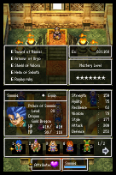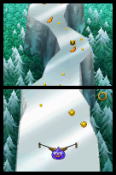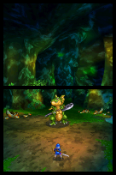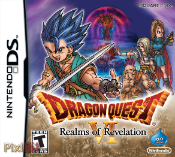Dragon Quest VI: Realms of Revelation Review
|
|
See PixlBit's Review Policies

On 10/30/2011 at 12:00 PM by Nick DiMola It's a SNES RPG through and through... now on the DS... in America. |

For all JRPG fans.
After my five-year-old self was handily beaten down by Dragon Warrior on the NES, I swore off the series -- until recently that is. Dragon Quest VI: Realms of Revelation marks my first true experience with the mega-popular Japanese RPG series. Thankfully my reintroduction has been a smooth one. While I wouldn't consider SNES RPGs a genre in and of itself, games in the genre that debuted on the system all have a similar style and presentation that promoted a far greater degree of accessibility. Being that I first got into the genre here, Dragon Quest VI made me feel right at home.

The long quest begins with what seems to be a dream encounter with the evil Murdaw, a magician that plagues the land and bears great resemblance to Nintendo's infamous Ganon. After the encounter, which ends in your demise, you awaken in the town of Weaver's Peak and are sent on a mundane quest to retrieve a crown for an annual festival. During your journey, you stumble into a hole in the Earth that transports you to a phantom world. Here, the inhabitants and locales are seemingly identical to their counterparts in the real world.
This experience catapults you into the main quest of the game, ultimately culminating in an encounter with Murdaw, which sheds light on why the two worlds exist.

However, this encounter and the subsequent one don't mark the end of the experience. Just like Okami and a few other games, after you defeat the presumably end boss, the game surprisingly continues onward. After Murdaw's demise the world opens up, providing a more expansive experience. Despite my brief description of the events, it will take 10-12 hours to reach this point in the game and a good bit of grinding through random encounters to have the mettle to beat the formidable foe.
Like most JRPGs, the game is focused entirely on turn-based battles wherein you leverage the skills of each of your teammates to effectively defeat randomly encountered enemies and big bosses at the end of grueling dungeons. Even with a class system, players will have no access to it whatsoever until after defeating Murdaw a second time and unlocking what is essentially the second half of the game.

Ignoring the second battle with Murdaw, the game features a nice, smooth progression curve where enemies ramp up in difficulty in a favorable proportion to your level. This makes it easy to always move forward and minimize level grinding. Murdaw poses a far greater challenge than any enemy preceding, forcing a good bit of level grinding (if you haven't already done so) to defeat him. From there on out, the game is expansive enough to allow you to continue on with minimal grinding.
While it was nice to see an expanded game experience upon unlocking the second half of the game, it definitely lost some of the laser focus that the story line had given it up to that point. Without the storyline, my interest began to wane in the later parts of the game, but ultimately the same solid gameplay and interesting characters in town were still present, which gave it just enough to keep the game going.
That's about all there is to it. It's an SNES JRPG through and through. You travel between towns, encounter random enemies, battle with a combination of weaponry, spells, and items, level your character, and go on various quests to build up your characters so they can take on the biggest, baddest foes of the game. If you're into those games, you'll love Dragon Quest VI, despite it losing steam in its second half. If you're not, you likely know that by now and should avoid this final remake in the Zenithian trilogy and check out something that's more your speed.










Comments